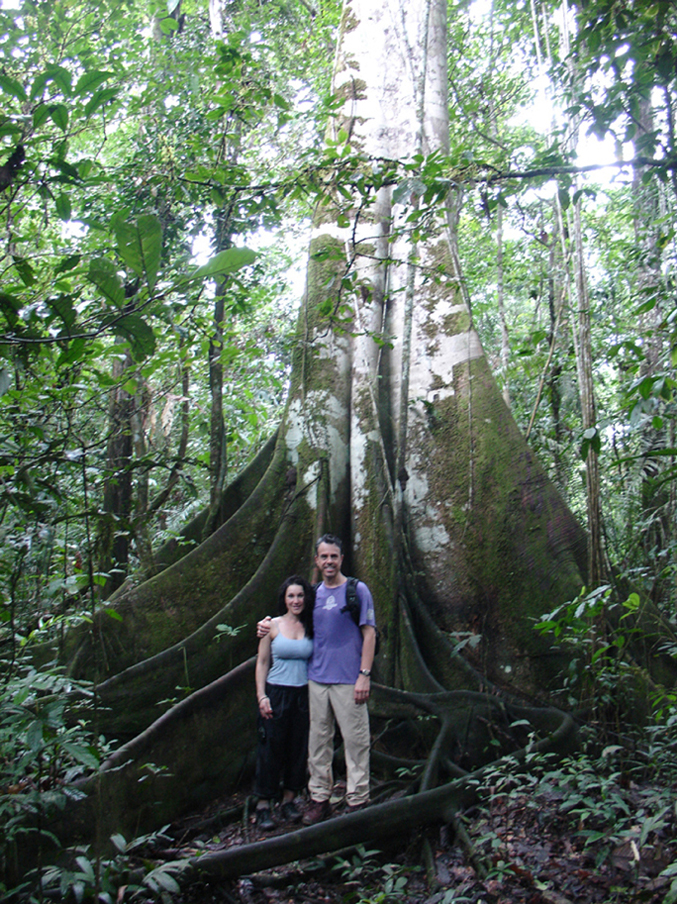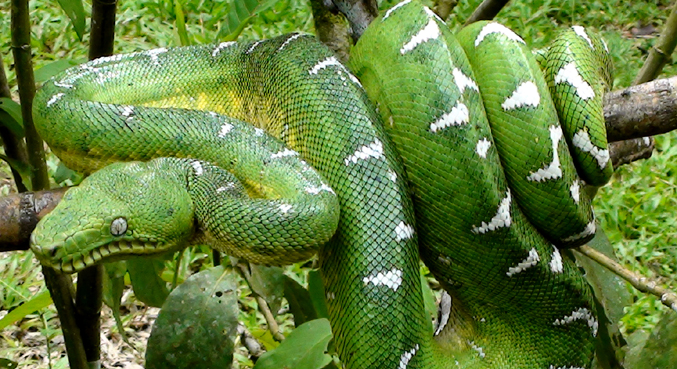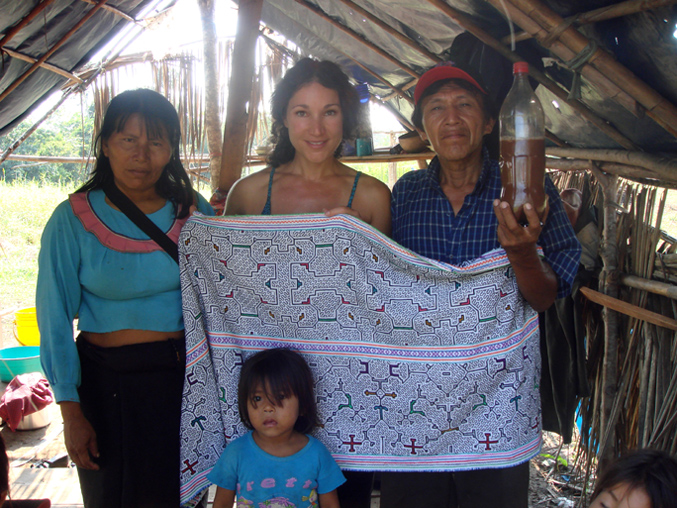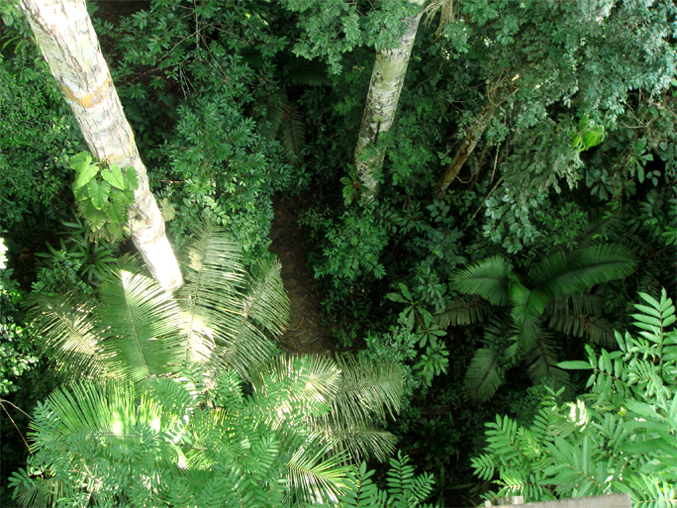
Chris Kilham and Zoe Helene, primary rainforest, Peruvian Amazon.
They are pretty sure this is how it happened.
Chris Kilham, a University of Massachusetts ethnobotanist who has spent the past dozen years venturing back and forth from South America, studying Amazonian rainforests and their medicinal plants, was enjoying a usual morning yoga session with his wife, Zoe Helene. Helene and Kilham began discussing and virtually stretching out ways Kilham could alter his one-credit UMass course known as “The Shaman’s Pharmacy,” which teaches about the effects of specific medicinal plants. The couple wanted to come up with a way to make the class more “hands-on” for the participants.
“What if we take the students into the Amazon?”
This ‘what if’ question posed on that morning stuck and sparked Kilham’s efforts in the fall semester to turn the course into a three-credit expedition that will take 16 students to the jungles of the Peruvian Amazon. Students from Mount Holyoke College, Smith College and UMass will fly out with Kilham, Helene and UMass plant and soil sciences Ph D.-candidate Zoe Gardner on Jan. 5 to reside on the borders of the Amazon until Jan. 14. The trip costs approximately $3,000 per student, and $2,600 of the cost is due by Dec. 3.
An informational meeting was held by Kilham on Nov. 23 to discuss the logistics of the trip with the 16 students intending on participating. Once in the Amazon, the students will spend their days doing various activities, such as hiking through one of the rainforest’s canopy walkways.
“The real amazing thing is the canopy walkway in the primary rainforest. Also, I hope to do projects to help people in the neighboring villages. The professor mentioned he is looking into it, but is still working out the details,” said Smith freshman Lauren Magliozzi, who will be attending the trip.

“It’s quite dangerous. There are poisonous snakes, and they are everywhere. They are aggressive, and they will take you down. There are alligators, crocodiles and poisonous spiders. There are dangers, because we’re going to the heart of the jungle. The mosquitoes are like science fiction down there, but that’s what makes this an adventure.” - Zoe Helene
Kilham, who is known to many as the “Medicine Hunter,” has spent the aftermath of what his wife insists was his “hippie, college days at UMass” dedicating himself to a career in discovering, testing and studying the effects of medicinal plant life as an ethnobotanist – a person who focuses on the effects and uses plants can present to humans.
“Ethnobotanists are interested in the human aspect of plants,” said Helene. “(The connection between plants and people). It’s more like Indiana Jones as opposed to somebody who sits and studies flowers. [Kilham] is definitely a scientist, too, and he can hang with the scientists and talk science.”
In addition to his research of plants, Kilham has spent a large portion of his time working in the Amazon, developing close relationships with many of the native shamans living in the rainforest. A shaman, which has often been seen in literature as being called a ‘witch doctor,’ refers to the native villager who is entrusted by other villagers as an information resource for health suggestions and holistic medicines.
“In a tribal community, a shaman is a healer who knows the medicine people need that can be found in nature. He is a community advisor, who also gives insight into spiritual issues. A shaman is almost a combination of a doctor, therapist and minister, you could say,” Kilham said.
“The Amazon rainforest is the greatest pharmacy in the world,” said Kilham. “You can get [pharmaceutical] drugs if you want them, but when you can have the healing power of truly effective plants found in the rainforest, most people who live there don’t bother with [pharmaceutical] drugs. [The natives] do rely on the shaman, but also most people in the area are familiar with the plants of the rainforest because they grow up within this environment. Just as most of the people of New England can identify a pine tree, elm tree or a dandelion, naturally, most of the people of the Amazon can identify and know the uses of a number of plants.”

“Ethnobotanists are interested in the human aspect of plants. (The connection between plants and people).” - Zoe Helene
Although Kilham does not feel as though he has had trouble in his excursions over the past 12 years communicating with the natives, a medicinal expert named Segundo Inuma will be a constant companion and guide for the students on the trip.
“He’s amazing,” said Kilham of Inuma. “He will be our contact to other native people in the region. He speaks excellent English and Spanish, and has knowledge of the native dialects.”
“Sharing this experience with the students is kind of a way to open them up to a world,” said Kilham. “Since most of the students going on the trip have an interest in medicinal plants, these students will be in an environment in which plant medicine is a big deal.”
Kilham believes that even people who are not plant experts have made many great contributions to medicinal plant science and have had “many great adventures.” As such, although the course will directly explain prominent plant life within the Amazon as the students come across it, the students are not required to have extensive previous knowledge of medicinal plants.
He did, however, make several suggestions to students about plant guides that would be most useful on the trip, citing that Dr. James Duke’s “Amazonian Ethnobotanical Dictionary” has been a great resource for him during his personal trips, as it not only gives the biological name, but also the native names of plants. He also told the students that he would be e-mailing them a list of plants that they are likely to discuss during the trip, which they’ll be able to cross-reference information about on Leslie Taylor’s Rain-tree.com website. Rain-tree.com features an extensive database about plants and their medicinal uses.
Some examples of plant life they will examine include “cat’s claw,” which is the bark of a vine that relieves pain and inflammation, as well as enhances immunity. They will also spend time looking at a tree sap informally known as “dragon’s blood.” It is used to heal damaged skin quickly.
During the trip, students are also likely to experience a lifestyle change as their lodging will not provide hot water for showers, bedding any more glamorous than cots topped with mosquito nets or modern laundry facilities.
Kilham encouraged students to remember that recording devices can help make the experience more memorable, but there are slim odds of being able to recharge digital camera equipment as access to electricity will be scarce. To that end, access to commercial stores will be non-existent for these students.
“It’s quite dangerous,” said Helene. “There are poisonous snakes, and they are everywhere. They are aggressive, and they will take you down. There are alligators, crocodiles and poisonous spiders. There are dangers, because we’re going to the heart of the jungle. The mosquitoes are like science fiction down there, but that’s what makes this an adventure.”
“I’m really excited to be going on the trip,” said UMass junior plant and soil biotechnology major, Kirsten Nuttle. “I’m not afraid because it is the last place on Earth that hasn’t changed as much as others have from human society. And humans are scarier than nature.”
“I’ve done a lot of camping, so I don’t worry about bugs,” said UMass junior biology major, Seth Rowley. “I think it will be fascinating to learn about the plants found in the rainforest. There’s a chance this might be a one-time experience in my life, especially because the forest is depleting. I think it will be an amazing experience.”

“The students will be turned on to the greatest rainforest in the world. And all of these activities involving people traveling to the Amazon to gain insight from native shamans and learning about medicinal plant treatments can help keep the Amazon going while giving people valuable experiences.”” - Chris Kilham
As far as students’ safety is concerned, Kilham has prepared for the worst, but is expecting the best. In gaining permission to conduct this trip, he has also been granted the confidence of UMass’ International Programs Office and plant and soil sciences department as UMass.
“It wasn’t too difficult to get permission from the University,” said Gardner. We had to provide them with reassurances about the students’ safety and the academic quality of the trip. But the trip has been something that both [Kilham] and the department [of plant and soil sciences] have wanted to do. Students are always asking for field experiences, and they know that Amazonia is an amazing place to learn. It is a rare opportunity.” Gardner is currently writing her thesis in a book titled “American Herbal Product Association’s Botanical Safety Handbook, 2nd Edition.” It will be a reference guide documenting plant life that has scientifically-proven medicinal qualities.
Gardner also held individual interviews with the students to ensure that they would be able to handle “rustic” living conditions. “We’ve got a really good group of students going,” said Gardner.
“UMass was great,” said Kilham. “The faculty groups we had to gain approval from were more or less like ‘You mean, you really are going to go to the rainforest?’ We didn’t encounter any resistance of any sort. They asked the important safety questions, but once those details were settled, the faculty just wanted to hear stories about what we would be doing.”
It is Kilham’s belief that many people want to find a solution to the environmental destruction of Amazonia, and that by showing students the effects of healing experiences and taking them into the rainforest to research medicinal plant life, “the students will be turned on to the greatest rainforest in the world. And all of these activities involving people traveling to the Amazon to gain insight from native shamans and learning about medicinal plant treatments can help keep the Amazon going while giving people valuable experiences.”
“I read Chris’ book ‘Tales from the Medicine Trail’ and loved it,” said senior anthropology major, Samantha Parsons. “I transferred to UMass partially because I couldn’t believe he taught here.”
According to Blueplanetbiomes.org/amazon.htm, a website dedicated to displaying information about Amazonia, “The Amazon rainforest, also known as Amazonia, is one of the world’s greatest natural resources. Because its vegetation continuously recycles carbon dioxide into oxygen, it has been described as the ‘Lungs of our Planet.’ About 20 percent of Earth’s oxygen is produced by the Amazon rainforest.” According to Kilham, the Amazon’s resources have been steadily depleting, and approximately 50,000 species of creatures are lost annually.